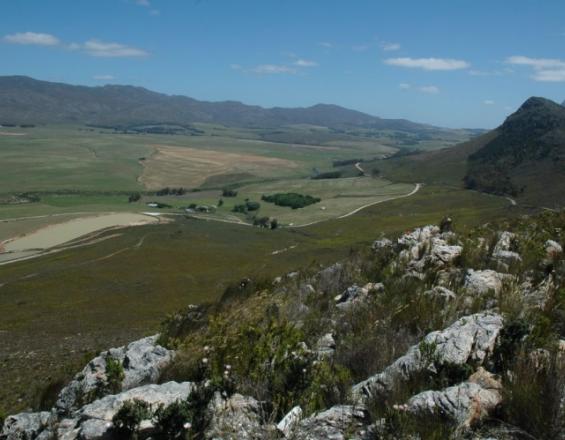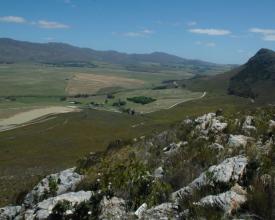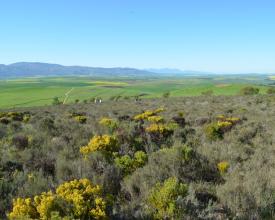
Partenariat public-privé pour développer un réseau d'aires protégées à l'épreuve du climat
Solution complète

Le col existant traverse le fynbos gréseux de l'Overberg, qui est en danger critique d'extinction.
Chris Burgers
Quinze pour cent de la province du Cap-Occidental est officiellement protégée. Malheureusement, ce réseau n'est pas représentatif de la biodiversité contenue dans la province et ne protège pas suffisamment la province contre les effets du changement climatique. Afin de compléter le réseau existant, les zones prioritaires, qui ont été identifiées grâce à des plans systématiques de biodiversité, sont sauvegardées par le biais d'accords de partenariat public-privé élaborés et de voies d'intégration.
Dernière modification 29 Mar 2019
3261 Vues
Contexte
Défis à relever
un réseau d'aires protégées non représentatif et fragmenté et des processus d'aménagement du territoire inefficaces - un réseau d'aires protégées non représentatif : Un réseau d'aires protégées fragmenté qui ne protège pas contre les effets anticipés du changement climatique, à savoir l'augmentation des températures, l'élévation du niveau de la mer, la fréquence des inondations et des sécheresses, etc.
Emplacement
Province du Cap occidental, Afrique du Sud
Afrique de l'Est et du Sud
Traiter
Résumé du processus
Les plans systématiques de biodiversité identifient les zones prioritaires qui doivent être sauvegardées. La sauvegarde comprend une variété de mécanismes allant de la protection formelle des terres à l'intégration de la biodiversité dans les plans et décisions d'utilisation des terres. Au cours de la dernière décennie, le principal mécanisme d'expansion du réseau de zones protégées a été l'intendance. L'intendance a complété le réseau biaisé existant et s'est avérée très efficace pour protéger de petites parcelles fragmentées de types de végétation très menacés et sous-protégés ou pour créer des liens précieux entre les paysages afin d'aider à protéger la province contre le changement climatique. Les principales approches d'intégration ont consisté à garantir une représentation adéquate de la biodiversité prioritaire dans la planification de l'utilisation des terres et dans la prise de décision. Les outils d'aménagement du territoire sur lesquels l'accent a été mis comprennent les plans municipaux d'aménagement du territoire (obligatoires pour toutes les municipalités de la province), les cadres de gestion environnementale et les évaluations environnementales stratégiques, ainsi que les plans pour l'ensemble des zones agricoles. Le principal processus décisionnel étudié est le processus d'évaluation de l'impact sur l'environnement.
Blocs de construction
Planification systématique de la biodiversité
La croissance d'une économie durable et l'établissement d'une base sociale solide sont des objectifs primordiaux pour l'Afrique du Sud. Il est donc primordial que les terres soient judicieusement et efficacement allouées à des utilisations concurrentes et que seules les zones de biodiversité prioritaires soient mises de côté pour la conservation.
La planification systématique de la biodiversité est la manière dont ces zones prioritaires de biodiversité sont identifiées. Cette technique permet d'identifier le moins de terres possible à sauvegarder afin d'atteindre un ensemble d'objectifs prédéfinis en matière de biodiversité. Les objectifs de biodiversité comprennent à la fois des objectifs de modèle (par exemple, les types d'écosystèmes et les emplacements des espèces rares ou menacées) et des objectifs de processus (par exemple, les processus côtiers ou les interfaces édaphiques). La carte des zones prioritaires pour la biodiversité qui en résulte représente une stratégie cruciale d'adaptation au changement climatique pour la province, car elle a) favorise la protection des pentes plus fraîches orientées vers le sud par rapport aux pentes plus chaudes orientées vers le nord ; b) constitue une zone tampon pour les écosystèmes aquatiques et côtiers ; et c) permet la migration des espèces vers des zones plus fraîches grâce à des liens entre les paysages.
Facteurs favorables
- Un inventaire scientifique fiable et concis, cartographié dans l'espace, par exemple l'occupation des sols, les types d'écosystèmes, les données de localisation des espèces rares et menacées, les zones protégées, etc. - Un planificateur de la conservation expérimenté qui comprend à la fois l'écologie de la région et la science de la planification systématique de la biodiversité.
- Financement : Les premiers plans systématiques de biodiversité des provinces ont été élaborés grâce à un financement assuré par le FEM. Un investissement important a été consenti pour produire ces premiers produits, les diffuser auprès de tous les utilisateurs et garantir la capacité interne à les mettre à jour à l'avenir
Leçon apprise
- Les connaissances locales en matière de biodiversité doivent être prises en compte dans la planification scientifique formelle de la conservation. Les propriétaires privés en savent souvent plus sur la biodiversité de leurs terres que les instituts scientifiques et de recherche. Des groupes de référence devraient être mis en place pour compléter les connaissances scientifiques sur lesquelles s'appuient les produits. - Lorsqu'il s'agit de déterminer les conflits à éviter stratégiquement au cours de la planification, il convient de faire preuve d'impartialité et d'équité dans l'ensemble du domaine de la planification. Essayez de n'éviter que les conflits qui sont des objectifs provinciaux. La méthodologie doit être transparente et défendable.
- L'applicabilité du plan systématique de biodiversité dépend entièrement de la carte de l'occupation des sols. Investissez des ressources pour vous assurer que la carte de l'occupation des sols est très précise et qu'elle est établie à une échelle aussi fine que possible.
Promouvoir l'application des produits de planification de la biodiversité
Un programme d'intégration a été mis en place pour s'assurer que tous a) connaissent les produits (c'est-à-dire le plan systématique pour la biodiversité et les lignes directrices) ; b) ont accès aux produits ; c) comprennent les produits ; et d) appliquent les produits de manière appropriée dans l'aménagement du territoire, la prise de décision en matière d'utilisation des terres et l'expansion des aires protégées. a) a) Publicité : Des groupes de référence et des comités de pilotage ont été constitués pour donner des conseils sur la conception et aider à la diffusion des produits.
b) b) Accès : Un premier lot important de produits sur papier a été distribué gratuitement. Par la suite, des copies électroniques ont été fournies. Des copies ont également pu être téléchargées à partir d'une plateforme Internet. c) Compréhension : CapeNature a nommé un spécialiste de l'intégration de la biodiversité pour aider les utilisateurs à appliquer les produits à la planification de l'utilisation des terres et à la prise de décision. Elle a également organisé une formation intensive au cours des trois premières années avec des partenaires clés, tels que les municipalités, les consultants privés, les responsables de l'EIE, etc. d) Application : Un forum de planification et de mise en œuvre de la biodiversité a été créé pour assurer la liaison entre les planificateurs de la conservation et les personnes chargées de la mise en œuvre et pour guider l'application des produits.
Facteurs favorables
Un responsable de l'intégration de la biodiversité à temps plein est nécessaire pour garantir la présence et l'implication continues de l'agence de conservation dans toutes les initiatives d'aménagement du territoire et de prise de décision. Fonds pour l'impression d'affiches, de manuels et de DVD et pour soutenir la diffusion des produits auprès de tous les utilisateurs. Ce processus a été coûteux. Le deuxième cycle pour les nouveaux produits, prévu en 2016, devrait toutefois être beaucoup moins coûteux car la formation de base et le niveau de compréhension ont déjà été établis.
Leçon apprise
- Un engagement continu et stratégique : Les relations entre les producteurs et les utilisateurs des produits doivent être établies très tôt. Il doit exister une plateforme permettant aux planificateurs et aux responsables de la mise en œuvre de la biodiversité de s'engager. Dans le cas de cette initiative, il s'agissait du forum de planification et de mise en œuvre de la biodiversité, qui se réunissait deux fois par an. Soyez stratégique dans le niveau d'implication, par exemple en utilisant autant que possible les forums existants plutôt qu'en créant de nouveaux ateliers, forums ou groupes - Des produits précis et à l'échelle appropriée : Les produits doivent être adaptés à l'utilisation prédéfinie. Par exemple, s'ils sont destinés à éclairer des décisions d'utilisation des sols spécifiques à un site, nous conseillons une échelle d'environ 1:10 000. Les produits à plus grande échelle sont mieux adaptés à l'aménagement du territoire.
Contrats de gestion de la biodiversité avec les propriétaires fonciers privés
L'intendance de la biodiversité est la pratique qui consiste à sauvegarder la biodiversité en dehors du réseau existant d'aires protégées appartenant à l'État. Elle confie la responsabilité de la conservation aux propriétaires fonciers privés par le biais de divers accords contractuels.
CapeNature a adopté l'intendance de la biodiversité en 2003 comme stratégie de base, car la majeure partie de la biodiversité digne d'être conservée se trouve sur des terres privées. Le programme a abouti à la signature de plus de 90 contrats entre des propriétaires fonciers privés ou des communautés et CapeNature. 43 d'entre eux (représentant 49 000 ha) ont abouti à une protection formelle, tandis que les autres représentent des accords de conservation moins formels qui se traduisent néanmoins par une amélioration de la gestion écologique. La principale limite du programme est le manque de capacités au sein de CapeNature. La signature de nouveaux contrats et l'entretien des sites existants nécessitent des ressources humaines et financières. C'est pourquoi seuls les sites prioritaires peuvent participer au programme. Il s'agit d'une situation regrettable car la demande de protection de la part des propriétaires terriens dépasse la capacité d'assistance de CapeNature.
Facteurs favorables
- Une culture du respect de l'environnement naturel qui a entraîné une forte demande de la part des propriétaires privés pour la conservation des terres ; - Une organisation compétente pour négocier et faciliter la déclaration officielle de terres privées en tant que zones protégées, ainsi qu'un gestionnaire de programme expérimenté et dévoué ; - Un comité d'examen à l'échelle provinciale composé de tous les partenaires clés impliqués dans l'intendance au sein de la province, afin d'examiner objectivement toutes les nouvelles demandes.
Leçon apprise
- La demande en matière d'intendance de la biodiversité (c'est-à-dire les propriétaires fonciers souhaitant protéger leurs terres) peut être plus élevée que la capacité de l'agence de conservation à la mettre en œuvre. Veillez à ne pas trop vendre le programme si l'agence ne dispose pas des ressources nécessaires pour l'offrir à tous - Mettez en place un processus d'examen rigoureux selon lequel seules les terres présentant une réelle valeur en termes de biodiversité doivent être officiellement protégées. Les terres moins importantes doivent être libérées pour le développement durable - Débloquer le potentiel des décisions relatives à l'utilisation des terres pour contribuer à l'expansion des aires protégées - c'est-à-dire les compensations pour la biodiversité - Attention à ne pas trop s'engager car les accords sont généralement à perpétuité ou à très long terme. Le même personnel qui est responsable de la signature des accords au cours des premières années devra se charger de l'audit et de l'entretien à un stade ultérieur. Si nous ne pouvons pas tenir nos promesses, la réputation du programme est en jeu.
Impacts
- Contribution significative des propriétaires fonciers privés à la conservation de la biodiversité : Le programme d'intendance de la biodiversité de CapeNature, désormais bien établi, est essentiellement un partenariat public-privé qui permet aux propriétaires fonciers privés de protéger officiellement la biodiversité prioritaire. Le propriétaire foncier a alors droit à des abattements fiscaux, tandis que le réseau provincial élargi d'aires protégées devient plus représentatif et résilient. - Planification spatiale éclairée : Sur la base de deux études comparatives menées en 2008 et 2014, il est clairement établi que les cadres de développement spatial (CDS) municipaux prennent mieux en compte la biodiversité prioritaire. - Amélioration de la prise de décision en matière d'utilisation des terres : Bien que difficile à quantifier, des preuves anecdotiques indiquent que la biodiversité prioritaire est mieux prise en compte dans les processus d'autorisation environnementale. Les impacts résiduels sur la biodiversité prioritaire servent également de déclencheurs pour des compensations de biodiversité (c'est-à-dire une gestion réactive).
Bénéficiaires
tous les habitants de la province du Cap occidental
Histoire
SITE DE GESTION RÉACTIVE DU PASSAGE DE SHAW'S Dans la vallée de Hemel-et-Aarde du WC, se trouve le col de Shaw's. Il est situé dans une zone de très grande valeur en termes de biodiversité. Il est situé dans une zone de très grande valeur en termes de biodiversité, contient une végétation unique au monde et constitue une zone centrale de diversité florale avec un nombre exceptionnellement élevé d'espèces de plantes endémiques (il y a plus de 35 espèces de plantes dont la conservation est préoccupante dans la zone). La zone représente également une clé de voûte dans l'un des corridors de changement climatique du Fonds de la montagne de la Table. Il s'agit des paysages intacts les plus importants de la province dans lesquels il convient d'investir pour assurer la résilience climatique. En 2008, une procédure d'EIE a été suivie pour le resurfaçage et le réalignement de la route. Ce réalignement, nécessaire pour des raisons de sécurité, aurait malheureusement un impact sur au moins 1 ha de végétation unique et irremplaçable, y compris des populations de plantes CR. CapeNature s'est opposé à ces impacts car ils seraient irréversibles et d'une importance négative très élevée.
Les mesures de compensation de la biodiversité sont des actions de conservation destinées à compenser les dommages résiduels et inévitables causés à la biodiversité par le développement, afin d'aspirer à une absence de perte nette de biodiversité. Étant donné qu'il n'y avait pas d'autres solutions possibles que le réalignement de la route et que la modernisation était considérée comme une priorité économique, il a été décidé qu'une compensation pourrait être un compromis approprié. Après de longues négociations avec le demandeur (le ministère des transports et des travaux publics), il a été convenu de compenser les impacts de la route. C'était la première fois qu'un ministère acceptait de compenser ses impacts et cela a créé un précédent très important.
La compensation comprenait les éléments suivants : - la mise en réserve et la protection formelle de 30 ha d'habitat restant dans le cadre d'un accord de gestion réactive, le propriétaire privé restant propriétaire de cette zone protégée ; et - la fourniture d'une somme forfaitaire pour la gestion à perpétuité du terrain à CapeNature, l'autorité de gestion désignée. Cet exemple montre comment la charge financière de la gestion des terres prioritaires peut être transférée de CapeNature au promoteur. Cette méthode de gestion réactive met en évidence la possibilité pour les processus d'autorisation environnementale de contribuer de manière significative à la réalisation des objectifs des zones protégées du Cap-Occidental et, par conséquent, de protéger la province contre les impacts anticipés du changement climatique.

